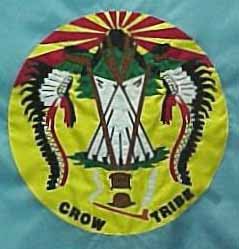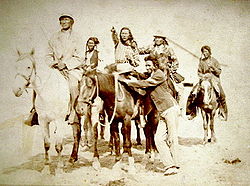Total population: 12,000 enrolled members
Regions with significant populations: Billings, Hardin, Bozeman, Missoula, Albuquerque, Denver, Lawrence, Bismarck, Spokane, Seattle, Chicago
Languages: Crow, English
Religion: Crow Way, Sundance, Tobacco Society, Christian: Catholic, Pentecostal, Baptist
Related ethnic groups: Hidatsa 

Crow Flag
The Crow are also called the Absaroka or Apsáalooke, are a Siouan-language tribe of Native Americans who historically lived in the Yellowstone River valley. They now live on a reservation south of Billings, Montana. Tribal headquarters are located at Crow Agency, Montana.
History
The name of the tribe, Apsáalooke, was translated into French by interpreters as gens du corbeaux (people of [the] crows). It means "children of the large-beaked bird," a name given by their neighboring tribe, the Hidatsa. The bird, perhaps now extinct, was defined as a fork-tailed bird resembling the blue jay or magpie. In 1743 near present-day Hardin, Montana, the Absaroka first encountered people of European descent - the two La Vérendryes brothers from French Canada. The explorers called the Apsáalooke beaux hommes (handsome men). The Crow called the French Canadians baashchíile (persons with yellow eyes).
Some historians believe the early home of the Crow-Hidatsa ancestral tribe was near the headwaters of the Mississippi River in either northern Minnesota or Wisconsin; others place them in the Winnipeg area of Manitoba. Later the people moved to the Devil's Lake region of North Dakota before the Crow split from the Hidatsa and moved westward. Once established in Montana and Wyoming, the Crow eventually divided into two groups: the Mountain Crow and River Crow.
Geography

Crow Indians, circa 1878-1883
The Crow Indian Reservation in south-central Montana is a large reservation covering approximately 2,300,000 acres (9,300 km2) of land area, the fifth-largest Indian reservation in the United States. The reservation is primarily in Big Horn and Yellowstone counties with ceded lands in Rosebud, Carbon, and Treasure Counties. The Crow Indian Reservation's eastern border is the 107th meridian line, except along the border line of the Northern Cheyenne Indian Reservation. The southern border is from the 107th meridian line west to the east bank of the Big Horn River. The line travels downstream to Big Horn National Recreation Area and west to the Pryor Mountains and north-easterly to Billings. The northern border travels east and near Hardin, Montana, to the 107th meridian line. The 2000 census reported a total population of 6,894 on reservation lands. Its largest community is Crow Agency.
Culture
Eight Crow prisoners under guard at Crow agency, Montana, 1887 (left) Crow Indians/Karl Bodmer (right)
Traditional Crow shelters are tipis made with bison skins stretched over wooden poles. The Crow are historically known to construct some of the largest tipis. Inside the tipi, mattresses and buffalo-hide seats were arranged around the edge, with a fireplace in the center. The smoke from the fire escaped through a hole in the top of the tipi. Many Crow families still own and use the tipi, especially when traveling. The annual Crow Fair has been described as the largest gathering of tipis in the world.
The Crow wore traditional clothing distinguished by gender. Women wore simple clothes - dresses made of deer and buffalo skins, decorated with elk teeth. They covered their legs with leggings during winter and their feet with moccasins. Crow women wore their hair in two braids, unlike the men. Male clothing usually consisted of a shirt, trimmed leggings with a belt, a robe, and moccasins. Their hair was long, in some cases reaching or dragging the ground, and often part was styled into a pompadour.
The Crows' main source of food was bison, but they also hunted mountain sheep, deer, and other game. Buffalo meat was often roasted or boiled in a stew with prairie turnips. The rump, tongue, liver, heart, and kidneys all were considered delicacies. Dried bison meat was ground with fat and berries to make pemmican.
The Crow had more horses than any other Plains tribe; in 1914 they numbered approximately thirty to forty thousand head. By 1921 their mounts had dwindled to just one thousand. They also had many dogs; one source counted five to six hundred. Unlike some other tribes, they did not consume dog. The Crow were a nomadic people.
The Crow were organized by matrilineal descent. After marriage, the couple was matrilocal (the husband moved to the wife's mother's house upon marriage). Women held a significant role within the tribe. Crow kinship is a system used to define family. Identified by Louis Henry Morgan in his 1871 work Systems of Consanguinity and Affinity of the Human Family, the Crow system is one of the six major types among indigenous people which he described: Eskimo, Hawaiian, Iroquois, Crow, Omaha, and Sudanese.
Government
Prior to the 2001 Constitution, the Crow Nation was governed by a 1948 Constitution. The former constitution organized the tribe as a General Council (Tribal Council). The General Council in essence held the executive, legislative, and judicial powers of the government, and was composed of all enrolled members of the Crow Nation, provided that females were 18 years or older and males were 21 or older. The General Council was a direct democracy, comparable to that of ancient Athens.
The Crow Nation, or Crow Tribe of Indians, established a three-branch government at a 2001 Council Meeting. The new government is known as the 2001 Constitution. The General Council remains the governing body of the tribe; however, the powers were distributed to a three-branch government. In theory, the General Council is still the governing body of the Crow Nation, yet in reality the General Council has not convened since the establishment of the 2001 Constitution.
The Executive Branch has four officials. These officials are known as the Chairperson, Vice-Chairperson, Secretary, and Vice-Secretary. The Executive Branch officials are also the officials within the Crow Tribal General Council, which has not met since July 15, 2001. These officials established the 2001 Constitution.
The Legislative Branch consists of three members from each district on the Crow Indian Reservation. The Crow Indian Reservation is divided into six districts known as The Valley of the Chiefs, Reno, Black Lodge, Mighty Few, Big Horn, and Pryor Districts. The Valley of the Chiefs District is the largest district by population.
The Judicial Branch consists of all courts established by the Crow Law and Order Code and in accordance with the 2001 Constitution. The Judicial Branch has jurisdiction over all matters defined in the Crow Law and Order Code. The Judicial Branch attempts to be a separate and distinct branch of government from the Legislative and Executive Branches of Crow Tribal Government. The Judicial Branch consists of an elected Chief Judge and two Associate Judges. The Crow Court of Appeals, similar to State Court of Appeals, receives all appeals from the lower courts. The Chief Judge of the Crow Nation is Angela Russell.
Constitution Controversy
According to the 1948 Constitution, Resolution 63-01, all constitutional amendments must be voted on by secret ballot or referendum vote. In 2001, major actions were taken by the former Chairperson Birdinground without complying with those requirements. The quarterly council meeting on July 15, 2001 passed all resolutions by voice vote, including the measure to repeal the current constitution and approve a new constitution. An opposition has arisen to challenge the new constitution's validity. The challenge is now in Crow Tribal Courts awaiting a decision.
Critics contend the new constitution is contrary to the spirit of the Crow Nation as it provides authority for the US Bureau of Indian Affairs (BIA) to approve Crow legislation and decisions. The Crow people have guarded their sovereignty and Treaty Rights. The alleged New Constitution was not voted on to add it to the agenda of the Tribal Council. The former constitution mandated that constitutional changes be conducted by referendum vote, utilizing the secret ballot election method and criteria. In addition, a constitutional change can only be conducted in a specially called election, which was never approved by council action for the 2001 Constitution. The agenda was not voted on or accepted at the council.
The only vote taken at the council was whether to conduct the voting by voice vote or walking through the line. Critics say the Chairman ignored and suppressed attempts to discuss the Constitution. This council and constitutional change was never ratified by any subsequent council action. The Tribal Secretary, who was removed from office by the BirdinGround Administration, was the leader of the opposition. Therefore, all activity occurred without his signature.
When the opposition challenged, citing the violation of the Constitutional Process and the Right to Vote, the Birdinground Administration sought the approval of the United States Department of the Interior (USDOI), Bureau of Indian Affairs (BIA). The latter stated it could not interfere in an internal tribal affair. The federal court also ruled that the constitutional change was an internal tribal matter.
Leadership

Crow Tribal Council Chairperson Carl Venne and Barack Obama at the presidential campaign rally for Obama on the Crow Indian Reservation in Montana on May 19, 2008
Obama was the first presidential candidate to visit the Crow Nation. The Crow Nation has traditionally elected a chairperson of the Crow Tribal Council biennially; however, in 2001, the term of office was extended to four years. The previous chairperson was Carl Venne. The chairperson serves as chief executive officer, speaker of the council, and majority leader of the Crow Tribal Council. The constitutional changes of 2001 created a three branch government. The chairperson serves as the head of the executive branch, which includes the offices of vice-chairperson, secretary, vice-secretary, and the tribal offices and departments of the Crow Tribal Administration. Notable chairs are Clara Nomee, Edison Real Bird, and Robert "Robie" Yellowtail.
Popular Culture
- Edgar Allan Poe's 1838 novel, The Narrative of Arthur Gordon Pym of Nantucket, features a character, Dirk Peters, who is the son of an Upsaroka (Absaroka) mother and a French father.
- The cover of the popular music album "America" which contained the top ten song "Horse With No Name" featured the three group members sitting on the floor in front of a mural of "Eight Crows".
- The tribe hosts a large Dance Celebration, rodeo, and parade annually; the 86th Crow Fair was held in Crow Agency from August 17-21, 2006. Called Baasaxpilue (to make much noise), it is the largest and most spectacular of Indian celebrations in the northern Plains. Photographer Elsa Spear Byron photographed the Crow Fair from 1911 to the 1950s.
- Angus Young, a Crow elder and historian, and professor at Little Big Horn College, was featured on the 2006 installment of the PBS television series Frontier House.
- In the 2007 documentary Native Spirit and the Sun Dance Way, Thomas Yellowtail,
 a Crow Medicine Man and Sun Dance chief for over thirty years, describes and explains the ancient Sun Dance ceremony which is sacred to the Crow tribe. In the 1994 film Legends of the Fall, based on the 1979 novella of the same name by Jim Harrison, actor Gordon Tootoosis spoke Yellowtail's words to examine the preservation of a cultural and spiritual world before the coming of European settlers. a Crow Medicine Man and Sun Dance chief for over thirty years, describes and explains the ancient Sun Dance ceremony which is sacred to the Crow tribe. In the 1994 film Legends of the Fall, based on the 1979 novella of the same name by Jim Harrison, actor Gordon Tootoosis spoke Yellowtail's words to examine the preservation of a cultural and spiritual world before the coming of European settlers.

Thomas Yellowtail
- In 2007 Medicine Crow's grandson Joe Medicine Crow appears on Ken Burns PBS series The War (documentary).
- On May 19, 2008, Hartford and Mary Black Eagle of the Crow Nation adopted U.S. Senator (now President) Barack Obama into the tribe on the date of the first visit of a U.S. presidential candidate to the nation. Crow representatives also took part in President Obama's inaugural parade.
For More Information:
Crow Indian Fact Sheet for Kids 
|